Enjoy DatePsychology? Consider subscribing at Patreon to support the project.
The Illusion of A Consensus on Who Is Attractive
Have you ever seen someone and thought, “They are probably attractive to others, but they aren’t my cup of tea?” Turns out that others may share your sentiment, in which case the attractiveness of the target individual is essentially an illusion. Most people may share your perception of the target’s attractiveness while also simultaneously sharing your belief that others find them more attractive than you do!
As we found in our data on beauty standards (Unattainable Female Beauty Standards? Not so.), the “beauty queen” look (heavy makeup and contoured face) may not be what men actually find most attractive. Rather, this is more likely driven by what the cosmetic industry promotes. Further, heavy makeup — or the stereotypical “Instagram model” look — may signal attention-seeking from other men. This form of competition, signaling potential promiscuity and sexual availability, may be a turn-off for men. A male “ick!”
Mafra et al. (2020) examined women who spent more money and time on cosmetic application. The time spent applying makeup predicted attempts to signal mate value, socioeconomic status, and was linked with intrasexual competition. Women who wore less makeup were more likely to be married, have a committed romantic partner, and also had higher reproductive success. Additionally, women who wore more makeup were rated as more promiscuous and also elicited more jealousy in other women. Cosmetic companies push heavy makeup to market their products, but men may be more drawn to natural appearances, which signals trustworthy and long term mates.
Methods
We collected a social media convenience sample (N = 669, 27% Female) and asked them to rate the picture used below (Image 1) of Sameera Khan, former beauty pageant competitor and social media political influencer. The mean age of men was 33.8 (SD 11) and of women was 34.1 (SD 10) (Image 2 shows the distribution of ages).
We asked participants to rate this photo with the following questions:
- How attractive is this face to you?
- How attractive do you believe members of the opposite sex will rate this face?
- Question 3:
- If you are a man: How desirable do you see this person as a short term mate.
- If you are a woman: How desirable will men rate this person as a short term mate.
- Question 4:
- If you are a man: How desirable do you see this person as a long term mate.
- If you are a woman: How desirable will men rate this person as a long term mate.
We also asked participants to indicate how well they recognized Sameera Khan in order to assess a potential effect of recognition (and positive or negative attitudes) on attractiveness and mate desirability ratings.

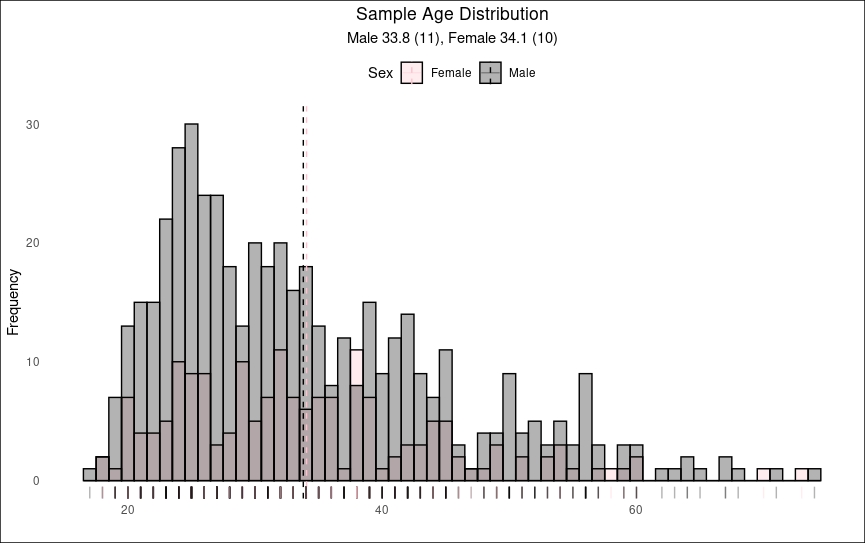
Results
Sex Differences in Ratings of Sameera Khan
Below is the distribution of participant attractiveness ratings for Sameera Khan. The mean attractiveness rating for men was 3.83 and for women was 3.93. There was no significant difference in attractiveness ratings between men and women (t(327.58) = -.72, p = .47). The 95% confidence interval for the difference in means ranged from -.37 to .17. Cohen’s d indicated a small effect size (d = -.06).
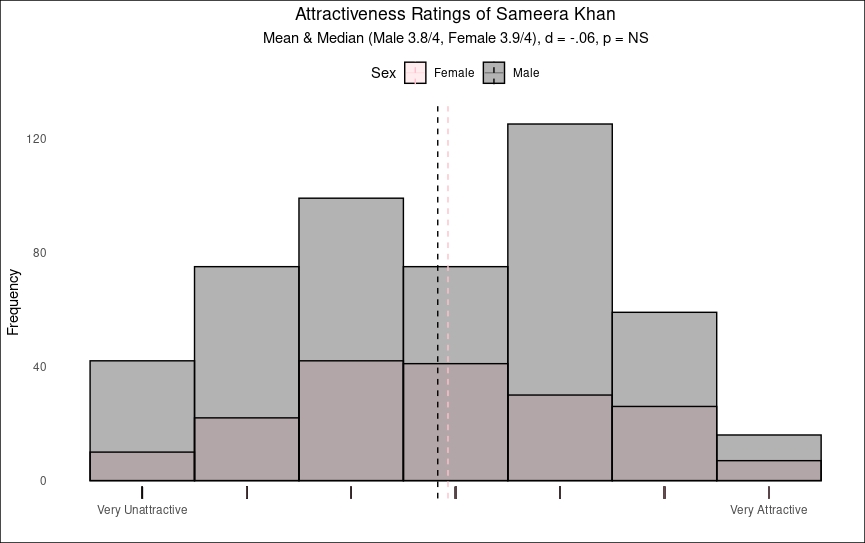
When asking participants to estimate how the opposite sex would rate the attractiveness of Sameera Khan, men (M = 4.9) estimated opposite-sex ratings lower compared to females (M = 5.3), (t(326.48) = -3.45, p < .001). The 95% confidence interval for the difference in means ranged from -.66 to -.18. Cohen’s d indicated a moderate effect size (d = -.30).
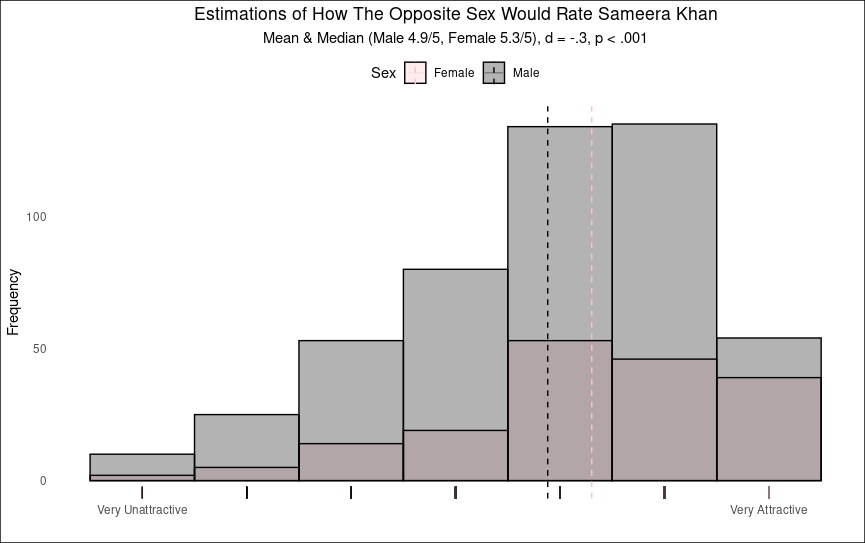
When men rated the short-term desirability of Sameera Khan and women were asked to rate how men would view the short-term desirability of Sameera Khan, there was a significant disparity in ratings. Men (M = 4.4) rated short-term desirability substantially lower compared to women (M = 6.1), (t(546.42) = -13.09, p < .001). The 95% confidence interval for the difference in means ranged from -1.92 to -1.42. Cohen’s d revealed a large effect size (d = -1).
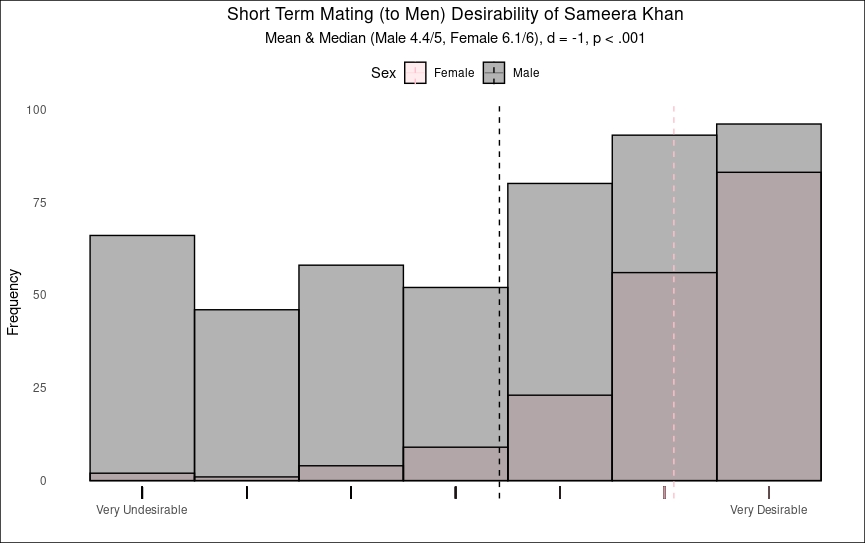
Men were asked to rate the long-term desirability of Sameera Khan and women were asked to rate how men would view the long-term desirability of Sameera Khan. There was again a significant difference in long-term attractiveness ratings between men and women. Men (M = 2.3) rated long-term attractiveness lower compared to what women estimated men would rate (M = 3.6), t(288.71) = -9.98, p < .001. The 95% confidence interval for the difference in means ranged from -1.61 to -1.08. There was a large difference between male and female ratings (d = -.89).

Associations Between Ratings and Variables
Participants were asked to rate their recognition of Sameera Khan in order to assess how familiarity with the target photo may have impacted ratings of attractiveness and desirability. No significant correlations were found between ratings of attractiveness, short-term mate desirability, and long-term mate desirability.
There was a significant negative correlation between recognition and estimates of how the opposite sex would rate Sameera Khan (r(667) = -0.12, p = .002). The 95% confidence interval for the correlation coefficient ranged from -.195 to -.045. This suggests that participants with higher recognition of Sameera Khan estimated members of the opposite sex would rate her lower in attractiveness.
Ratings of attractiveness given by participants predicted estimations of opposite-sex ratings, as well as short-term and long-term desirability scores. The correlation between attractiveness and estimations of opposite sex attractiveness ratings was r(667) = .44, p < .001, and the 95% CI ranged from .37 to .5. Attractiveness ratings and short-term mate desirability correlated at r(667) = .63, p < .001 with a 95% CI of .58 to .68. Attractiveness ratings and long-term mate desirability correlated at r(667) = .55, p < .001, with a 95% CI of .49 to .6.
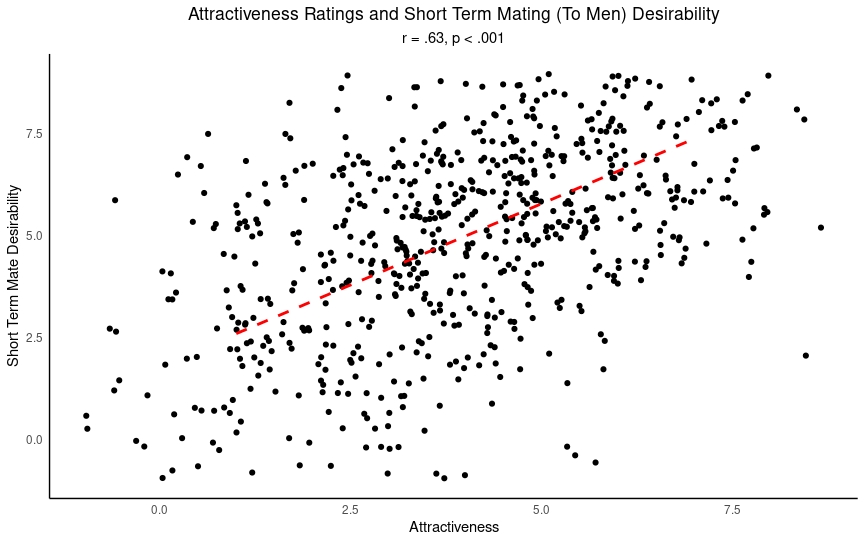
Finally, a significant correlation emerged between long-term and short-term mating desirability ratings (r(667) = .6, p < .001, 95% CI[.55, 0.64]). The size of the correlations were significant and similar for men (r = .57) and women (r = .47).
Result Summary
- Sameera Khan received “mid” attractiveness ratings from men and women, as estimated by median and mean measures of central tendency. There was no sex difference in attractiveness ratings.
- Men and women both believed that members of the opposite sex would rate the attractiveness of Sameera Khan higher than members of the opposite sex actually did. A sex difference was observed here, with women estimating opposite-sex ratings of attractiveness higher than male estimates of opposite-sex ratings.
- Men rated the desirability of Sameera Khan as a short-term mate lower (4.4 out of 7) than women believed men would rate the short-term desirability of Sameera Khan (6.1 out of 7). This was a large difference by Cohen’s effect size standards (d = -1).
- Men and women both rated the long-term mate desirability of Sameera Khan low (2.3 by men and 3.6 by women). Women believed the long-term mate desirability of Sameera Khan to men was significantly higher than men believed it was for themselves. This was also a large effect (d = -.89).
- Familiarity with Sameera Khan had no significant relationship with ratings of attractiveness, short-term desirability, or long-term desirability.
- Ratings of attractiveness had large relationships with ratings of short-term and long-term desirability.
- Ratings of long-term and short-term desirability were also highly correlated.
Discussion
A few interesting findings emerged from our research. First, despite being a beauty pageant contestant, Sameera Khan received middle ratings of attractiveness from both men and women. However, both men and women overestimated the extent to which members of the opposite sex would find Sameera Khan to be attractive (and this overestimation was larger for women). The same effect was observed for long and short-term mate desirability: women overestimated how desirable Sameera Khan was as a long and short-term mate to men.
Attractiveness ratings were correlated with both short-term and long-term mate desirability, as expected, given that attractiveness is a highly sought trait in both short-term and long-term mates. This association was slightly stronger for short-term mate desirability, again consistent with the evolutionary literature showing that physical attractiveness is prized more in short-term mating contexts (but not that it is devalued in long-term contexts). The size of correlations between attractiveness and both short and long-term mate desirability were large.
Similarly, correlations between short-term and long-term mating desirability were highly correlated. This is again consistent with past research showing that similar traits are prized both in short and long-term mates (although they may be weighted differently depending on the mating context).
Familiarity had no or little relationship with ratings of attractiveness and desirability, indicating that knowledge of who Sameera Khan was (or opinions about her) were unrelated to assessments of her attractiveness. A lack of a relationship with familiarity was also found in our research on ratings of red-pill influencers (How Attractive Are Red Pill Influencers? Ratings From A Large Sample). Participants seem to assess attractiveness without a large contribution from familiarity.
Does Sameera Khan believe that she is “mid?” We can’t know for sure, but given that heavy cosmetic application is an attempt to signal high mate value it raises the question of how she perceives herself. We know from past research that individuals overestimate their own physical attractiveness and that this effect is stronger for less attractive individuals. It’s likely that there is a mismatch not only between how we truly view the “Instagram model” or “beauty queen” look and how we think others perceive it, but also between how individuals who embrace this look see their own attractiveness and how others really perceive them.
References
Mafra, A. L., Varella, M. A. C., Defelipe, R. P., Anchieta, N. M., de Almeida, C. A. G., & Valentova, J. V. (2020). Makeup usage in women as a tactic to attract mates and compete with rivals. Personality and Individual Differences, 163, 110042.